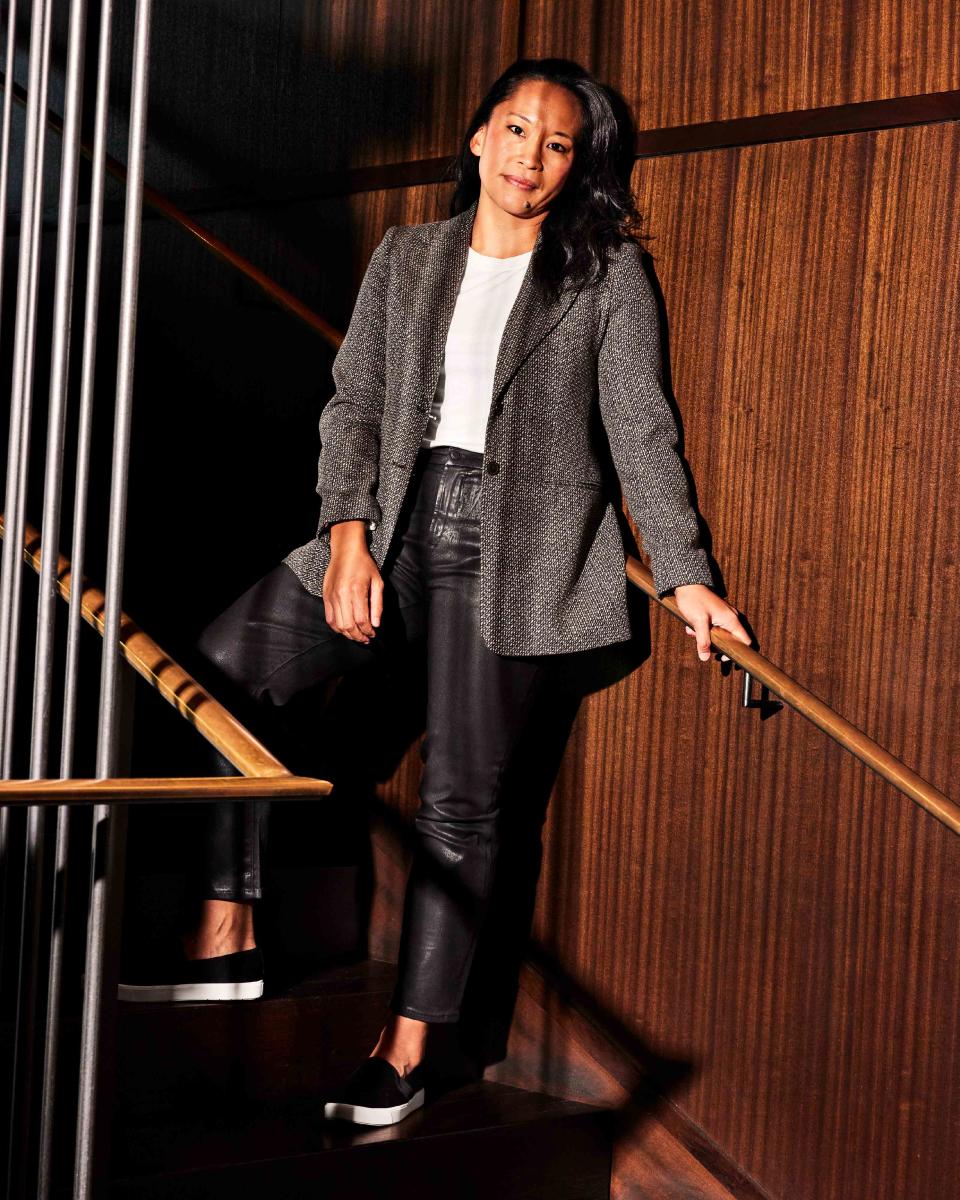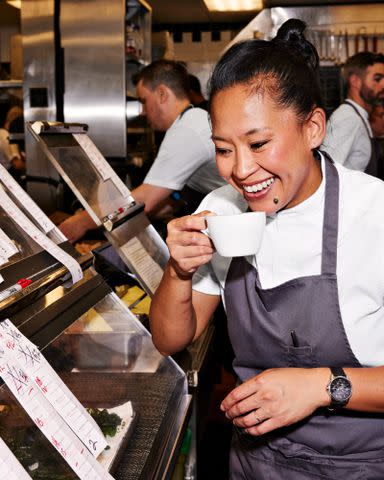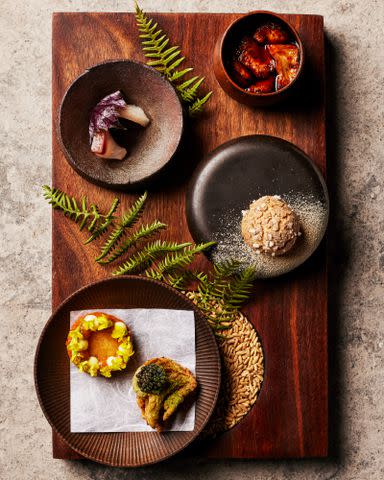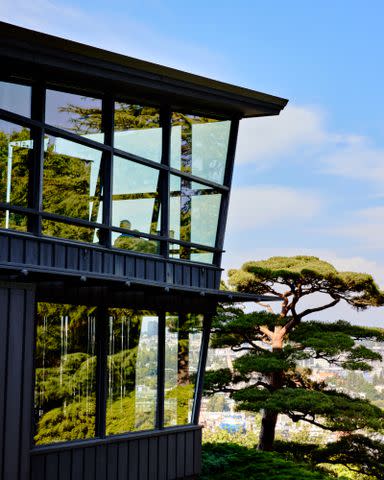Meet the Chef Who Put a Bloomin' Onion on the Menu of America’s Most Iconic Fine Dining Restaurant
Ibrahim has taken the reins at iconic fine-dining restaurant Canlis in Seattle, where she is cultivating a thoroughly modern tasting menu and a positive kitchen culture.

Eva Kolenko
It all started with a bet. At the age of 19, Aisha Ibrahim experienced a serious knee injury that sidelined her from her college basketball team, and she was feeling unmoored — until a teammate presented her with a challenge: “I bet you can’t cook anything out of this cookbook,” she told Ibrahim, pointing to a copy of Mastering the Art of French Cooking by Julia Child. “I’m such a hardcore person; that’s the last thing that anyone needed to tell me,” says Ibrahim today with a laugh. Ibrahim pulled off Child’s crêpe recipe. A roommate showed her how to zest an orange for the batter, and she was hooked. “I remember how perfumed it became. I thought to myself that cooking was this magical world.” At the end of her sophomore year, Ibrahim dropped out of college to move to California, a state she had never been to before, to go to culinary school at the California Culinary Academy in San Francisco, carried forward by a sense of determination and self-belief that would help shape her into the leader that she is today.

Eva Kolenko
Aisha Ibrahim on the lineSince 2021, Ibrahim has headed up the kitchen at Canlis in Seattle, bringing the tasting-menu format back to the iconic fine-dining restaurant. The meal starts off with a tray of snacks including a creamy, jiggly chawanmushi, the texture of a custard after a round of Botox, crowned with silky cinnamon cap mushrooms. It’s followed by an elegant riff on a blooming onion, made with a tiny and sweet Walla Walla onion, served with a dollop of whipped goat cheese and a generous sprinkling of onion powder. It’s difficult to not ask for seconds of a bowl of sea bream swimming in a gentle dashi made of kombu, shiitake, and bones from the fish. (Ibrahim ages the sea bream for four days to achieve the tender texture.) There’s a wonderfully clever course that leads into dessert made with a blood orange reduction and aerated silken tofu, frozen with liquid nitrogen to give it an ice cream–like appearance. But Ibrahim lights up the most when she talks about adding a juk-inspired “rice course” to the menu. To make it, she cooks parsnips with chestnuts and a toasted koji cream (the only ingredient actually made with rice) until it reaches a thick, comforting texture and serves it with a plate of crispy, tempura-fried hen-of-the-woods mushrooms. It’s a menu with a global approach, informed by her years in fine-dining kitchens around the world.
Related: Find the Greatest Teriyaki in the United States in Seattle
Ibrahim’s first experience in a professional kitchen was as a stage at a two-Michelin-star restaurant in San Francisco that had one of the toughest kitchens in the city. “It was highly abusive,” Ibrahim recalls. Plates and food were regularly thrown at cooks, and excessive shouting and drinking were standard. She eventually landed a job at Foreign Cinema before moving on to cook at stalwart restaurants like Commis and Manresa. It was at Manresa that she met chef Eneko Atxa, later flying to Spain to cook at his restaurant, Azurmendi. Up until that experience, Ibrahim says, she had learned how to be a good cook. But Atxa taught her how to be a good person. “He would be missing for the pre-serving meeting because he was in the alley on a FaceTime call saying goodnight to his daughters,” she says. “I really appreciated the way he treated his people. That’s who I wanted to be.”

Eva Kolenko
Scallop toast and blooming Walla Walla onion with caviar, koji cream choux, kampachi, and mushroom custardAtxa soon asked Ibrahim to head up his restaurant Aziamendi in Phuket, Thailand. The cultural differences she encountered made her shift into a different kind of leader — a better one — says Ibrahim. “I learned to lean into my athletic background in coaching while also unlearning the sh-tty behavior I had witnessed [in other kitchens].” After that, Ibrahim worked in other kitchens in Thailand and Singapore and began to lay the groundwork for a 12-seat fine-dining operation in Thailand with her now-wife, Sam. (Why fine dining? “I was always drawn to the discipline,” says Ibrahim. “I really enjoyed the attention to detail, the artistry behind it.”) The couple had an investor lined up and was in the process of finding spaces when COVID-19 brought everything to a screeching halt.

Eva Kolenko
The midcentury property that is home to CanlisAs they tried to figure out what was next, Ibrahim received a message from restaurateur Brian Canlis on Instagram, asking her to consider taking over the kitchen at his family’s legendary namesake restaurant (a position vacated by 2018 F&W Best New Chef Brady Williams). Ibrahim had been to Seattle once before but had never eaten at the restaurant. She was hesitant at first, but the more she asked around, the more convinced she became that this was the gig for her. “One of the things that stood out to me was how strongly they really lean on their value system at Canlis,” says Ibrahim. She was also charmed by the fact that Canlis has staff who have been working there since the year she was born. In 2021, she became the restaurant’s first female executive chef.
Related: Every Food & Wine Best New Chef Ever, Since 1988
Today, Ibrahim’s menu at Canlis has a deep focus on sustainability. Yes, from an ingredient perspective — Ibrahim is determined to use every part of every ingredient — but also, perhaps more importantly, from a work culture perspective. When interviewing a prospective cook, “They were like, ‘I’ve never seen this level of camaraderie in a kitchen before. And I can ask a question and no one’s laughing at me,’” Ibrahim shares. “And I said, ‘Yes. We are trying to be the anti-fine-dining fine-dining restaurant in that sense.’”
For more Food & Wine news, make sure to sign up for our newsletter!
Read the original article on Food & Wine.

